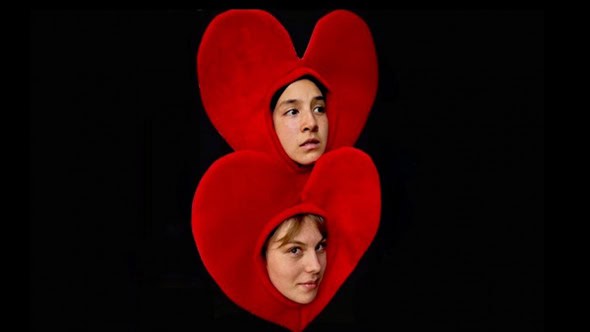Resolution 2019: works by Vain, Minogue-Stone and Ben & Fred
Posted: February 13th, 2019 | Author: Nicholas Minns | Filed under: Festival, Performance | Tags: Ben Nicholson, Elliot Minogue-Stone, Frederike Gerstner, Isabella Arboleda Tovar, Jacksons Lane, Pauline Thuriot, The Place, Vee Smith, Vendetta Vain | Comments Off on Resolution 2019: works by Vain, Minogue-Stone and Ben & FredResolution 2019: Works by Vendetta Vain, Elliot Minogue-Stone and Ben & Fred, January 29

This year The Place has partnered with, among others, Jackson’s Lane, to cross-fertilize choreography with circus arts at Resolution. It’s a welcome initiative that hopefully develops the gene pool of both choreographic and circus expression rather than simply expanding the catchment area for Resolution’s artists.
Vee Smith, who performs under the name of Vendetta Vain, trained at the National Centre for Circus Arts and Butterface is her first circus solo work. She is not the first to perform naked on a trapeze (though perhaps the first to do so at Resolution), but she approaches her performance with as little coyness and pudeur as apology. The title of her work is a derogatory noun for ‘an attractive woman with an undesirable face’, which is clearly understood to mean an attractive female body with an undesirable face. Vain makes this point quite evident by hiding her face, for most of the performance, under a muslin concoction tied loosely at the neck to which she attaches false eyelashes and a rude approximation of lips. But while our focus in Butterface is on the body and what Vain does with it, it is on our minds that Vain has focused her argument; the two don’t always acknowledge each other in the formation of her ‘message’.
There are two sets of projected texts, one that is designed to ease Vain into the performance as she enters behind two large feathers, and the other conveys the sexual animosity and stereotyping of the female circus artist as she performs on the trapeze. Because our eyes are watching her rather than the texts on the back wall, there is an argument that Butterface would benefit from Vain speaking the second set of texts while performing. It would give the taping together of her legs, for example, an edge of satirical wit over the comic absurdity of her actions. Vain’s choice of songs (Flawless, Paper Bag and She) show a natural sense of self-deprecatory humour and her subversive intelligence will not suffer fools. It’s a potent mixture.
Elliot Minogue-Stone is a graduate of the incommensurable Orley Quick and the Hairy Heroines, inviting us in Sighs, Cries and Lies to ‘delve into platitudes, taboos, tangibility, big questions and odd sensations’ with the same lack of disambiguation he once brought to discussing big dogs and screwdriver heads. He takes an important step from performer to choreographer by creating Sighs, Cries and Lies on Isabella Arboleda Tovar and Pauline Thuriot who translate his sense of the absurd into another key. At first it’s a very low key, as the two bounce on to the stage in red shorts, white tops and trainers, arms enigmatically raised in front of their faces. But as Tovar begins to deck the stage in a wealth of props from a bright red shopping basket, the key begins to modulate. Sighs, Cries and Lies is not a work that can be defined by its external shape but by the paths that run through its apparent chaos, a physical grammar of associations and collisions that offer a fractured landscape of vulnerability. You make of it what you will; its meaning coalesces around a free association of props, popular songs, wit and repartee that Tovar and Thuriot weave into an emotional pattern that ultimately holds them — and us — together.
Ben & Fred’s The Juggling of Science brings together two jugglers, Frederike Gerstner and Ben Nicholson, in a light-hearted introduction to quantum physics. The recorded voice of Professor Circumference introduces his two understudies with the tone of Listen with Mother but the principles in ‘possibly the most fun science lecture you could hope to see’ are staged rather than heard. Gerstner is a scientist in a white lab coat at her desk waiting for Dr. Dextrose (Nicholson), to arrive. With their wit and an ability to illustrate complex scientific notions like the Heisenberg Uncertainty Principle, the construction of an atom, dark matter and neutrinos through juggling, Gerstner and Nicholson have created a gem of crossover stimulation. The problem is that the crossover bypasses almost completely the choreographic nature of Resolution’s program. In his collaborations with Seeta Patel and Alexander Whitley, Sean Gandini has shown how the disciplines of juggling and dance can learn from and stimulate each other, but The Juggling of Science frames itself resolutely and unapologetically within science; it’s not a question of the excellence of the work but of the programming choices of this ‘festival of new choreography’.